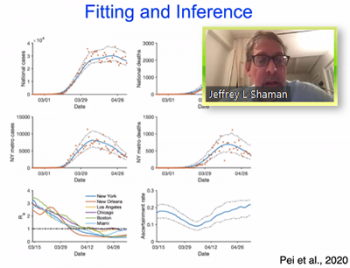

Dynamic models of infectious disease systems are often used to study the epidemiological characteristics of disease outbreaks, the ecological mechanisms and environmental conditions affecting transmission, and the suitability of various mitigation and intervention strategies. In recent years these same models have been employed to generate probabilistic forecasts of infectious disease incidence at the population scale. In this COPSS-NISS hosted webinar, Dr. Jeffrey Shaman (Columbia University) presents research that descrbes the application of model systems and combined model-inference frameworks to the study of SARS-CoV-2. (see Event page)
Dr. Shaman started off the session by first reviewing a project that his research group had underway from October 2016 to April 2018 called the Virome of Manhattan. This project involved 214 subjects from a variety of backgrounds were examined for respiratory viruses on a weekly basis. Rather than wait for individuals to come into a clinic seeking care, this project sought out subjects who were examined to see just how prevalent a variety of 18 common respiratory viruses existed in this sample. It quickly became clear that there are quite a few people walking around shedding respiratory viruses. More importantly, it also became clear that the majority of people who reported signs of illness still went about their life as normal, working, shopping, traveling, etc.
Taking what was learned in the Virome of Manhattan project, Jeffrey applied this to the SAR-COV-2 pandemic to better understand transmission. A first step was to develop a model system to quantify this understanding of transmission using daily observational and travel data from 375 cities in China from the period of January 10 through the 23rd when travel restrictions were put into place. After a synthetic test of model inference parameter estimations, simulations of the parameter estimates were shown to match the observed outbreak. From this point, with a working model in hand, Jeffrey proceeded to walk through a wide variety of different modeling scenarios and demonstrated how, as a whole, the models work together to establish a much more robust understanding of the transmission of this disease, both in mapping the progress as well as opening possibilities for making projections for the future.
Dr. Roni Rosenfeld (Carnegie Mellon) was invited as discussant to provide his own remarks regarding the presentation. Rather than play the ‘devil’s advocate’, Roni instead decided it was more important to build upon the comments that Jeffrey shared. First, he observed that the bottleneck in the work that is being done in this area is not with the science but with the data itself. The difficulty in measuring the important elements of what has happened in the past as well as what is currently happening are significant. He advocated a revamping of the collection of surveillance data and suggested a few ideas of what could be put in place. Second, he pointed out the deficiencies that have been endured in scrambling to react to an emerging pandemic instead he underscored the importance of having regular systems in place to work from.
After sharing a number of other “take-home messages” and other “lessons learned” that have evolved from the experiences that researchers have been encountering in their work both Roni and Jeffrey discussed these challenges including whether it is even possible to make effective forecasts or in what ways even simple projections have inherent problems. Furthermore, Jeffrey reiterated how far away we are from effective data collection and where we need to be in order to stay on top pandemics like COVID.
Moderator Dr. Lily Wang (Iowa State University) then presented the questions that had been building up in the Q&A tool. The panelists both responding to these live as well as with the Q&A interface. Questions included, “Given all the types of models available, how do you choose the most appropriate?” among others. At the end of the session Lily asked both Roni and Jeffrey for “A final thought that they would like the audience to take away?” Jeffrey contributed what he called a public health message, “Even though the vaccine is being rolled out, we have a long way to go. We need to have many, many more people vaccinated before we can relax any of the non-pharmaceutical interventions in place. If we give these interventions up too soon, many more people will be infected.” Roni encouraged folks to “Advocate for public policy solutions that will ensure better data.”
“Even though the vaccine is being rolled out, we have a long way to go. We need to have many, many more people vaccinated before we can relax any of the non-pharmaceutical interventions in place. If we give these interventions up too soon, many more people will be infected.”
Jeffrey Shaman (Columbia University)
Again, as has become usual in COPSS-NISS COVID-19 Webinar Series, there were more questions than could be answered - even given the extra time provided and the fact that the panelists were clearly scrambling to type in answers when they weren’t speaking! Clearly this webinar series features topics that are of interest to many!
Want to learn more? Mark your calendar for every 1st and 3rd Thursday from noon to 1 pm ET. (See the NISS website for event details and to register for these sessions!)
Below, please find a recording of this session along with a link to the slides that the speakers used. The slides not only provide you with the key points that were offered but also include links to additional resources that should not be ignored!
Recording of the Session
Slides used by the Speaker
Jeffrey Shaman, (Columbia University)
“Transmission Dynamics of SARS-CoV-2: Inference and Projection”
About this Webinar Series
The COPSS-NISS COVID-19 Data Science webinar series is co-organized by the Committee of the Presidents of Statistical Societies (COPSS) and its five charter member societies (ASA, ENAR, IMS, SSC, and WNAR), as well as NISS. This bi-monthly webinar features the latest research that is positioned on the cusp of new understanding and analysis of COVID-19 pandemic data, and promotes data-driven research and decision making to combat COVID-19. Find out more about this series and view all the previous sessions on the Webinar Series page.
